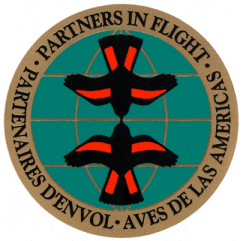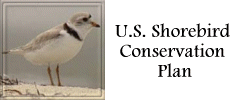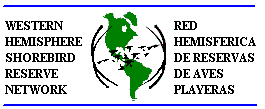Migratory Bird Initiatives
There are many bird conservation programs and initiatives in the United States and more broadly in North America. Most involve extensive public-private partnerships and the efforts and talents of citizen volunteers. This page highlights five of the largest initiatives and provides links to additional websites of potential interest.
- Executive Order 13186: Responsibilities of Federal Agencies to Protect Migratory Birds
- Bird Conservation Initiatives
- Important Bird Areas Program
- Other Links
Executive Order 13186: Responsibilities of Federal Agencies to Protect Migratory Birds
Migratory birds are of great ecological and economic value to this country and to other countries. They contribute to biological diversity and bring tremendous enjoyment to millions of Americans who study, watch, feed, or hunt these birds throughout the United States and other countries. The United States has recognized the critical importance of this shared resource by ratifying international, bilateral conventions for the conservation of migratory birds. Such conventions include the Convention for the Protection of Migratory Birds with Great Britain on behalf of Canada (1916), the Convention for the Protection of Migratory Birds and Game Mammals (Mexico 1936), the Convention for the Protection of Birds and Their Environment (Japan 1972), and the Convention for the Conservation of Migratory Birds and Their Environment (Union of Soviet Socialist Republics 1978).
These migratory bird conventions impose substantive obligations on the United States for the conservation of migratory birds and their habitats, and through the Migratory Bird Treaty Act (Act), the United States has implemented these migratory bird conventions with respect to the United States. Executive Order 13186 (PDF)(4 pp, 38.6 K, About PDF) directs executive departments and agencies to take certain actions to further implement the Act.
Bird Conservation Initiatives
North American Waterfowl Management Plan

In response to sharply declining waterfowl populations, the United States and Canada adopted the North American Waterfowl Management Plan in 1986. The Plan set forth a strategy for restoring waterfowl populations to 1970s levels through voluntary, non-regulatory, public-private partnerships that work to conserve the wetlands habitats that waterfowl need to survive. Mexico joined Canadian and U.S. partners in 1994.
Although the Plan is international in scope, it is implemented regionally. Implementation is achieved though partnerships called "Joint Ventures" which involve federal, state, provincial, and local governments; businesses; conservation organizations; and individual citizens. Joint Ventures develop coordinated site-specific habitat management programs and projects, supported by a strong biological foundation, focusing on areas of concern identified in the larger Plan. Plan partners not only advance waterfowl conservation, but make substantial contributions toward the conservation of all wetland-dependent species. The Plan was significantly updated in 1998 by adding major emphasis on landscape-level conservation and collaboration with other conservation efforts, particularly migratory bird initiatives.
Partly in support of the North American Waterfowl Management Plan, Congress enacted the North American Wetlands Conservation Act in 1989 to encourage voluntary, public-private partnerships to conserve North American wetland ecosystems. The Act establishes an infrastructure and provides a source of funding, a competitive grant program.
EPA is a member of the Migratory Bird Conservation Commission, established in 1929 by the passage of the Migratory Bird Conservation Act, which was created and authorized to consider and approve any areas of land and/or water recommended by the Secretary of the Interior for purchase or rental by the U.S. Fish and Wildlife Service under the Act. In addition to approving purchase and rental prices, the Commission considers the establishment of new waterfowl refuges. In 1989, the Commission acquired the additional responsibility to approve project funding under the North American Wetlands Conservation Act for projects in the U.S., Canada and Mexico.
Partners In Flight

Neotropical migratory birds journey each year between U.S. and Canadian breeding grounds and more southerly wintering areas in Mexico, Latin America, and the Caribbean. Some migrants travel thousands of miles, others just a few hundred miles.
Concern began to grow in recent decades as annual bird counts revealed sharp declines in the numbers of once common neotropical migratory land birds. Habitat loss, fragmentation, and degradation in both Latin and North America is thought to be the single most important factor contributing to the decline. Other problems confronting neotropical migrants include pollution, competition with exotic species, collisions with buildings and automobiles, hunting and control as agricultural pests, and increased rates of predation and parasitism caused by feral animals, exotic species, and degraded habitat. In response to declines in the populations of neotropical migratory birds, Partners In Flight/Compañeros en Vuelo/Partenaires d'Envol was launched in 1990.
The central premise of Partners In Flight (PIF) is that the resources of public and private organizations in North and South America must be combined, coordinated, and increased in order to achieve success in conserving bird populations in this hemisphere. Partners in Flight is not a government agency or program. It is a public-private partnership involving many government agencies, conservation groups, industry, and many others. PIF-affiliated bird conservation initiatives have been established in Canada, Mexico, and 28 Latin American and Caribbean countries.
The goal of PIF is to focus resources on the improvement of monitoring and inventory, research, management, and education programs involving birds and their habitats. The PIF strategy is to stimulate cooperative public and private sector efforts in North America and the Neotropics to meet these goals. PIF emphasizes the conservation of birds not covered by other existing conservation initiatives — the idea is to "keep common birds common." The initial focus of the effort was on species that breed in the Nearctic (North America) and winter in the Neotropics (Central and South America), but the focus has spread to include most land birds and other species requiring terrestrial habitats.
Partners in Flight has approached bird conservation on several major fronts:
- Coordinate efforts, share information, establish research and monitoring priorities, develop standard protocols and procedures. For example, PIF has developed a species priority-setting scheme that has been applied to rank all North American land bird species at the physiographic area level — a popular version called the "Watch List" appears on their website. In addition the National Audubon Society has a list of Priority Birds.
- Further education and awareness about the need for bird conservation. PIF publishes several periodicals in English and Spanish, and sponsors the popular World Migratory Bird Day each May. Migratory Bird Citizens' Manuals are also under development. The manuals will serve as practical guides for use by local groups and citizens in developing strategies for bird conservation. A prototype Citizens Manual for Maryland is already complete.
- Conservation Planning. Bird Conservation Plans include priority species lists, priority habitat descriptions, bird population objectives, and habitat objectives. The plans form the basis of action by public and private land managers, other wildlife/natural resources professionals, non government organizations, and citizens. A general strategy, The Flight Plan, outlines and guides the bird conservation planning process.
EPA has been an active participant in Partners in Flight almost since its inception, having signed a memorandum of agreement with a number of other federal agencies in May 1991.
Shorebird Conservation

The U.S. Shorebird Conservation Plan was developed through a collaborative effort between researchers, state and federal agencies, nongovernmental organizations, land managers and education specialists from the U.S. Working in cooperation with colleagues from Canada and Mexico, this partnership seeks to advance effective conservation of North American shorebird species. The U.S. Shorebird Conservation Plan addresses three primary objectives: a) development of a standardized, scientifically-sound system for monitoring and studying shorebird populations that will provide practical information to researchers and land managers for shorebird habitat conservation; b) identifying the principles and practices upon which local, regional and national management plans can effectively integrate shorebird habitat conservation with multiple species strategies; and c) design of an integrated strategy for increasing public awareness and information concerning wetlands and shorebirds.
Implementation of the Plan will require an active, committed and diverse partnership of organizations both in the U.S. and in the other countries where shorebirds occur. Implementation at various scales will be accomplished through a variety of partnership organizations and structures. These will include a U.S. Shorebird Plan Council, which will serve as a national advisory and steering committee; National Technical Working Groups on Research and Monitoring, Education and Outreach, and Habitat Management; and Regional Working Groups formed in most of the Shorebird Planning Regions which will focus on implementation of regional objectives. Each of these groups will work closely with counterpart Joint Ventures under the Waterfowl Management Plan and with other bird conservation initiatives, especially the North American Bird Conservation Initiative.

Complementing the work of the U.S. Shorebird Conservation Plan is the Western Hemisphere Shorebird Reserve Network (WHSRN). WHSRN links wetland and associated upland sites essential to migratory shorebirds in a voluntary, non regulatory program of research, training, and collaborative effort for habitat management, environmental education, and protection. Its scope is hemispheric because shorebirds migrate across the hemisphere — some travel all the way from the Arctic to the southern tip of Argentina! Launched in 1985, the Network brings together over 120 wildlife agencies, private conservation groups, and other organizations to solve conservation challenges faced by migratory shorebirds and their habitats. With the addition of 4 new sites in September 2000, the number of officially designated sites in the system stands at 46, responsible for managing over 20 million acres in 7 Western Hemisphere nations.
For many shorebird populations, critical sites extend in a chain from arctic breeding grounds to wintering sites in South America. As with any chain, the system as a whole is only as strong as its weakest link. The Network highlights the key roles that particular sites throughout the hemisphere play in maintaining that living chain. Membership in the Network and participation in its projects are wholly voluntary — management authority and priorities remain the prerogative of the land administrator. By joining the Network, a site gains acknowledgment and support for its participation in a hemisphere-wide effort. The Network offers support to local wetland conservation initiatives by providing recognition for the importance of member sites in international shorebird migration. Sites fall into four categories: Hemispheric, International, Regional, and Endangered Species Reserves — depending on the numbers and species of shorebirds that utilize them for migration or wintering.
The Network works to achieve five main goals: 1) Identify and protect sites critical to the Western Hemisphere's migratory shorebirds; 2) Promote and support the development of strong conservation organizations and their efforts to protect shorebirds and shorebird habitats; 3) Build strong public support for wetlands and shorebird conservation through education and public awareness (Save Our Migratory Birds); 4) Develop and support international, national, and local policies to help ensure the long term protection and management of the hemisphere's migratory shorebirds and critical wetlands; and 5) Compile, analyze, and disseminate information on shorebird distribution, migration, habitat, and biology in the Western Hemisphere (International Shorebird Survey).
North American Waterbird Conservation Plan

An initiative to develop a North American Waterbird Conservation Plan to advance the conservation of colonial-nesting waterbirds (seabirds, terns, wading birds, gulls) and their habitats in North America began in July 1998, through a partnership of nongovernmental agencies, researchers, private individuals, academics, and federal and state governmental agencies.
Colonial waterbirds face significant threats to the long-term stability of their populations and habitats within North America due to such impacts as the destruction of freshwater wetlands, destruction and degradation of coastal ecosystems, depletion of the forage base in freshwater, coastal, and marine ecosystems, contaminants, sea level rise, and various conflicts with human land and resource use. For some species, these threats have resulted in declines in numbers. In other cases, these disturbances have resulted in colonial waterbird species becoming nuisance wildlife. They appear to be useful biological indicators of the ecosystems on which they depend, including inland wetlands, coastal zones, and the oceans. Because they serve as indicators, their protection and management can be useful in conserving the landscape.
North American Bird Conservation Initiative

The North American Bird Conservation Initiative (NABCI) was established to facilitate the conservation of native North American birds by increasing the effectiveness of existing and new bird conservation initiatives, enhancing coordination, and fostering greater cooperation among the nations and peoples of the North American continent. NABCI was initially catalyzed by, and has received some funding support from, the North American Commission for Environmental Cooperation (NACEC), established through the environmental side agreement of the North American Free Trade Act. While NABCI continues to receive some modest support from CEC, it is not "owned" or in any way controlled by CEC, but is instead "owned" in common by its participants.
NABCI-US has established several subcommittees to ensure full representation of all key interests and to provide greater focus on particular issues. These subcommittees include federal agencies, nongovernmental organizations, and monitoring. Each of the 3 nations has appointed a National Coordinator to support its respective National Committee, provide a central focal point for the exchange of information and ideas, and represent NABCI in appropriate fora and events. EPA staff have participated in the development and early implementation of NABCI since its inception. EPA also provides indirect support to NABCI through the agency's role in the North American Commission for Environmental Cooperation in which the Administrator serves as the US member of the trilateral NACEC Council, along with the environmental ministers of Mexico and Canada.
Important Bird Areas Program
The purpose of the Important Bird Areas Program is to identify and protect a network of sites to help maintain naturally occurring bird populations for which a site-based approach is appropriate. Important Bird Areas (IBAs) are places of significance for the conservation of birds across multiple landscape scales, and they are chosen using standardized, credible criteria based on biological common sense. IBAs include sites for species during the breeding and non-breeding seasons.
The Important Bird Areas Program was begun by Bird Life International (formerly the International Council for Bird Preservation) in the mid-1980s. Important Bird Areas in Europe, published in 1989 was the first thorough compilation of IBAs; it listed 2,444 sites in 32 countries. The criteria used in Europe and subsequently in other regions have been adapted for use in the United States.
The biological rationale for IBAs is that some sites are exceptionally important for bird conservation, and the consequences of the loss of any one of them may be disproportionately large. IBAs are identified for areas containing concentrations of species occurring on the wintering grounds, the breeding grounds, or during migration, and they include terrestrial sites, marine or lacustrine sites, and sites over which migrants congregate. In general a threshold of 1% of the biogeographical population size has been used as a threshold that affords an appropriate degree of protection to populations. IBAs should be different in character, habitat, or ornithological importance from their surrounding areas, but in defining sites practical considerations of how best the sites can be conserved are also important.
In the United States IBAs have been a cooperative venture between the American Bird Conservancy and the National Audubon Society . American Bird Conservancy has worked toward identifying sites important at the national, continental, and global level while National Audubon Society has been working to identify sites important at the state level. These efforts have involved hundreds of individuals representing many organizations and agencies, and have led to the identification of more than 500 IBAs. Also, within the United States, the IBA Program is coordinated closely with Partners in Flight and the other bird conservation initiatives to ensure that together these approaches help conserve all bird species.
Other Links
- Ducks Unlimited
- Department of Defense Partners in Flight
- U.S. Fish and Wildlife Service Migratory Bird Office
- U.S. Migratory Bird Conservation Commission
- North American Wetlands Conservation Act
- Patuxent Wildlife Research Center
- Cornell Laboratory of Ornithology
- American Bird Conservancy
- National Audubon Society
- American Birding Association
- Smithsonian Migratory Bird Center
- BIRDNET
